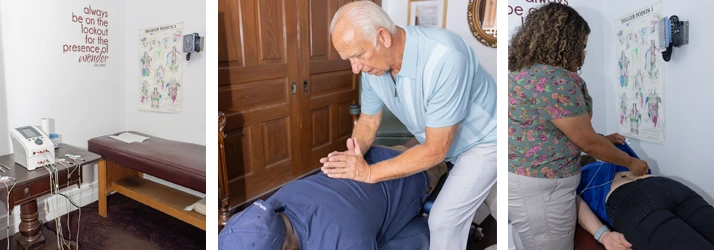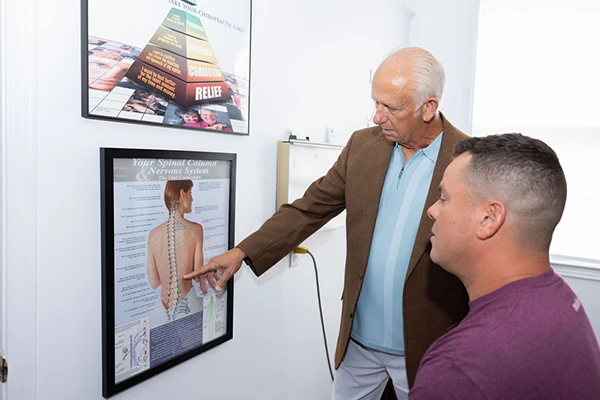Understanding Sciatica in Mobile AL: Causes and Chiropractic Perspectives

The Structure of the Sciatic Nerve
The sciatic nerve in Mobile AL is formed by the union of five nerve roots: L4, L5, S1, S2, and S3, which emerge from the lower lumbar and upper sacral areas of the spine. These roots merge deep in the gluteal region and pass close to the front of the piriformis muscle.

What is Sciatica?

Sciatica describes pain that radiates down the leg, often resembling a severe cramp. In some cases, the pain can be so intense that it hampers daily activities like sitting or standing. It may be triggered by sudden actions such as sneezing or coughing and is commonly accompanied by a persistent burning sensation in the leg. While sciatica usually affects just one leg, it can occasionally involve both. Pinpointing which nerve root is involved helps in identifying the source, as the sciatic nerve supplies both movement and sensation.
Main Causes Originating from the Spine in Mobile AL
Vertebral Subluxation
Because the sciatic nerve roots exit the spinal column at the lumbar (L4, L5) and sacral (S1, S2, S3) levels, problems here frequently cause sciatica. Chiropractic care often includes spinal adjustments, heat or ice therapy, and other physical modalities. In severe cases, medication may be used for pain relief.
Herniated Lumbar Disc
Between each vertebra lies an intervertebral disc, which acts as a shock absorber. If the soft center of a disc pushes through its tough exterior, it can press on the sciatic nerve roots and cause symptoms. Most often, this involves a swollen or bulging disc rather than a complete herniation.
Spinal Stenosis
With age, the spine undergoes wear and tear that can cause the ligaments to thicken and bone spurs to form, narrowing the spinal canal. This can compress nerve roots, a problem sometimes made worse by vertebral subluxation.
Spondylolisthesis
Most common in the lower lumbar spine, spondylolisthesis occurs when one vertebra slips forward over another, often due to a bilateral fracture of the pars interarticularis. While it may not cause symptoms in some, more severe cases can compress nerves, leading to pain or weakness, especially involving the fourth or fifth lumbar vertebra.
Piriformis Syndrome
Piriformis syndrome involves irritation or compression of the sciatic nerve by the piriformis muscle, located in the buttocks. Anatomical variations in the muscle can also split and press on the nerve.
Degenerative Disc Disease
Degenerative Disc Disease (DDD), also known as Degenerative Joint Disease (DJD), involves the loss of water content and shrinking of spinal discs with age. This can make the discs fibrotic and brittle, sometimes leading to pressure on the sciatic nerve. Chiropractic adjustments may help by improving mobility in the affected vertebrae.
Tumors
Although rare, tumors in the pelvis or spine can compress the sciatic nerve along its path.
Bone Spurs
Bone spurs are bony outgrowths from the vertebrae, often linked to aging, which can pinch or press on the sciatic nerve. Chiropractic adjustments may help by realigning vertebrae, potentially reducing pressure and inflammation.
Traumatic Injury
Accidents, such as falls or car crashes, can directly injure or inflame the sciatic nerve. It is important to avoid electrical hot packs in these cases and instead use moist heat, like warm showers or Epsom salt baths, to relax the body. Applying ice packs in the early stages of treatment helps decrease swelling.
*Due to extenuating circumstances, the office hours may vary. Please call the office to confirm we are open.
OFFICE HOURS*
Monday
8:30am - 12:00pm
2:00pm - 6:00pm
Tuesday
8:30am - 12:00pm
2:00pm - 6:00pm
Wednesday
8:30am - 12:00pm
2:00pm - 6:00pm
Thursday
8:30am - 12:00pm
2:00pm - 6:00pm
Friday
8:30am - 12:00pm
Saturday & Sunday
Closed
Discover Chiropractic Center
1412 Dauphin St
Mobile, AL 36604




